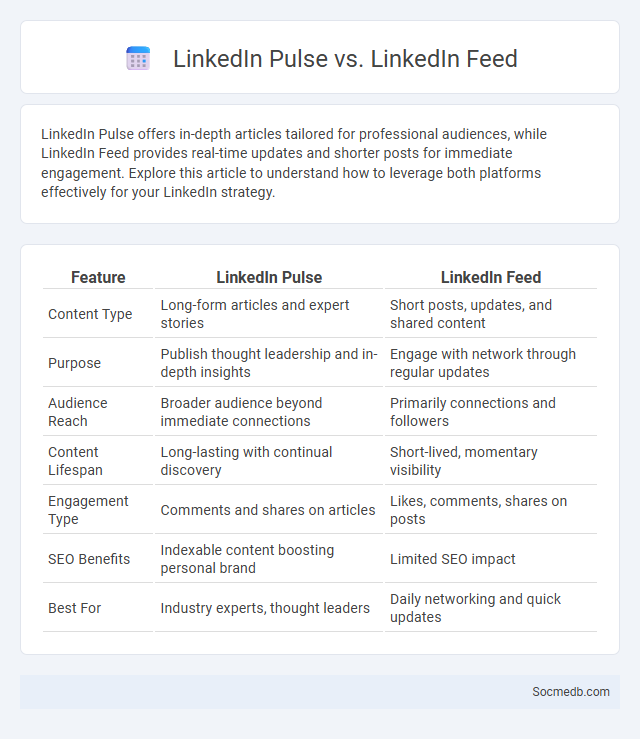
Photo illustration: LinkedIn Pulse vs LinkedIn Feed
LinkedIn Pulse offers in-depth articles tailored for professional audiences, while LinkedIn Feed provides real-time updates and shorter posts for immediate engagement. Explore this article to understand how to leverage both platforms effectively for your LinkedIn strategy.
Table of Comparison
| Feature | LinkedIn Pulse | LinkedIn Feed |
|---|---|---|
| Content Type | Long-form articles and expert stories | Short posts, updates, and shared content |
| Purpose | Publish thought leadership and in-depth insights | Engage with network through regular updates |
| Audience Reach | Broader audience beyond immediate connections | Primarily connections and followers |
| Content Lifespan | Long-lasting with continual discovery | Short-lived, momentary visibility |
| Engagement Type | Comments and shares on articles | Likes, comments, shares on posts |
| SEO Benefits | Indexable content boosting personal brand | Limited SEO impact |
| Best For | Industry experts, thought leaders | Daily networking and quick updates |
Introduction to LinkedIn Pulse, Feed, and Feed Ranking
LinkedIn Pulse is a platform where you can discover and share professional content tailored to your industry and interests, enhancing your networking opportunities. The LinkedIn Feed aggregates updates, articles, and posts from your connections, companies, and followed topics, keeping you informed with relevant professional insights. Feed Ranking uses AI-driven algorithms to prioritize content based on your interactions, connections, and relevance, ensuring your LinkedIn experience is both personalized and engaging.
What is LinkedIn Pulse?
LinkedIn Pulse is a content publishing platform integrated within LinkedIn, designed to help professionals share articles, insights, and industry news with their network. It leverages LinkedIn's vast user base to amplify content reach, enabling thought leaders and businesses to engage a targeted audience effectively. By utilizing LinkedIn Pulse, users can enhance personal branding, increase visibility, and foster community interactions within their professional field.
Understanding the LinkedIn Feed
The LinkedIn feed algorithm prioritizes content based on user interactions, relevance, and professional connections, ensuring personalized updates. Posts with rich media such as images and videos receive higher engagement rates, boosting visibility within networks. Understanding key metrics like impressions, clicks, and reactions helps optimize content strategy for maximum reach and professional impact.
How Feed Ranking Works on LinkedIn
LinkedIn's feed ranking algorithm prioritizes content based on your interactions, relevancy, and relationship strength with connections and pages. The system evaluates factors such as post engagement, content type, and user interests to surface posts that are most meaningful to you. Understanding this feed ranking helps you optimize your posts to increase visibility and engagement with your professional network.
Content Distribution: Pulse vs Feed
Content distribution on social media platforms varies between Pulse and Feed, with Pulse highlighting trending topics and real-time updates to maximize user engagement through timely information. Feed-based algorithms curate personalized content by analyzing Your interests, behaviors, and interactions to ensure relevant posts appear consistently. Understanding the balance between Pulse's dynamic exposure and Feed's customized experience can significantly enhance content reach and audience retention.
Audience Reach: Pulse vs Feed Performance
Pulse metrics capture real-time audience engagement spikes, offering instant insights into content virality and immediate reach. Feed performance data measures sustained visibility over time, reflecting how posts maintain audience interaction within users' regular browsing habits. Comparing Pulse and Feed analytics enables marketers to optimize strategies by balancing short-term buzz with long-term audience retention.
Engagement Metrics on Pulse and Feed
Engagement metrics on Pulse and Feed reveal how users interact with content, including likes, comments, shares, and click-through rates. These metrics provide essential insights into audience behavior, helping you tailor posts to increase visibility and foster community. Monitoring engagement on both platforms enables more effective social media strategies by identifying trends and user preferences.
Factors Affecting LinkedIn Feed Ranking
LinkedIn feed ranking is influenced by factors such as user engagement history, content relevance, and the timeliness of posts, which ensures your feed displays the most pertinent updates. The algorithm prioritizes content from your connections, groups, and followed pages, considering interactions like likes, comments, and shares to determine visibility. Understanding these factors helps you optimize your LinkedIn presence by posting regularly and engaging with your network to improve your feed ranking.
Best Practices for Maximizing Visibility
To maximize your social media visibility, consistently post high-quality, engaging content tailored to your target audience's interests and behaviors. Utilize platform-specific features such as hashtags, stories, and live videos to increase reach and interaction. Analyze your performance metrics regularly to refine your strategy and boost Your online presence effectively.
Choosing the Right Platform for Your LinkedIn Content
Choosing the right platform for your LinkedIn content depends on your target audience and professional goals. LinkedIn is ideal for B2B marketing, networking with industry leaders, and sharing insightful articles or company updates that highlight your expertise. Tailoring your content to suit LinkedIn's professional environment ensures you maximize engagement and establish your credibility effectively.
 socmedb.com
socmedb.com